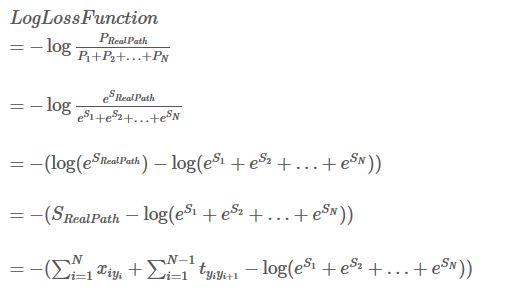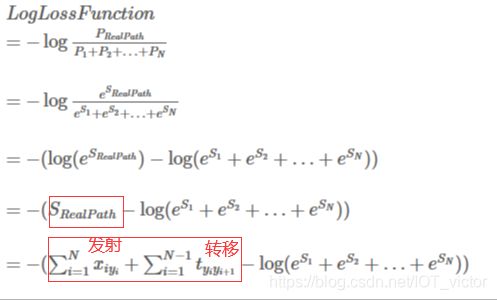BiLSTM-CRF学习笔记
LSTM和GRU https://blog.csdn.net/IOT_victor/article/details/88934316
1、模型详解
路径分数=发射分数+转移分数
CRF损失函数:p = 真实路径分数(最高)/ 所有路径的总分数。求-logp
真实路径的分数应该是所有路径中分数最高的。使得真实路径所占的比值越来越大。
bilstm-CRF理论 https://zhuanlan.zhihu.com/p/44042528
- BIO体系(约束条件)句子的开头应该是“B-”或“O”,而不是“I-”。
- “B-label1 I-label2 I-label3…”,在该模式中,类别1,2,3应该是同一种实体类别。比如,“B-Person I-Person” 是正确的,而“B-Person I-Organization”则是错误的。
- “O I-label”是错误的,命名实体的开头应该是“B-”而不是“I-”
CRF和HMM
https://www.jianshu.com/p/55755fc649b1
1.HMM是生成模型,CRF是判别模型 2.HMM是概率有向图,CRF是概率无向图
3.HMM求解过程可能是局部最优,CRF可以全局最优 4.CRF概率归一化较合理,HMM则会导致label bias 问题
判别vs生成
在机器学习中任务是从属性X预测标记Y,从本质上来说:
- 判别模型之所以称为“判别”模型,是因为其根据X“判别”Y;求的是后验概率P(Y|X)
- 生成模型之所以称为“生成”模型,是因为其预测的根据是联合概率P(X,Y),而联合概率可以理解为“生成”(X,Y)样本的概率分布(或称为 依据);具体来说,机器学习已知X,从Y的候选集合中选出一个来,可能的样本有(X,Y_1), (X,Y_2), (X,Y_3),…,(X,Y_n),实际数据是如何“生成”的依赖于P(X,Y),那么最后的预测结果选哪一个Y呢?那就选“生成”概率最大的那个吧。
2、代码
(TF):https://zhuanlan.zhihu.com/p/47722475
https://github.com/Determined22/zh-NER-TF
(torch): https://github.com/luopeixiang/named_entity_recognition
# embedding层
def embedding_layer(self, char_inputs):
u"""
:param char_inputs: one-hot encoding of sentence
:return: [1, num_steps, embedding size],
"""
with tf.variable_scope(u"char_embedding"):
embed = tf.nn.embedding_lookup(self.word_embedding, char_inputs)
return embed# bilstm层
def bilstm_layer(self, lstm_inputs, lstm_dim, lengths):
"""
:param lstm_inputs: [batch_size, num_steps, emb_size]
:return: [batch_size, num_steps, 2*lstm_dim]
"""
with tf.variable_scope(u"BiLSTM"):
lstm_cell_forward = tf.nn.rnn_cell.LSTMCell(lstm_dim,
use_peepholes=True,
initializer=self.initializer,
state_is_tuple=True)
lstm_cell_backward = tf.nn.rnn_cell.LSTMCell(lstm_dim,
use_peepholes=True,
initializer=self.initializer,
state_is_tuple=True)
(output_fw_seq, output_bw_seq), final_states = tf.nn.bidirectional_dynamic_rnn(
lstm_cell_forward,
lstm_cell_backward,
lstm_inputs,
dtype=tf.float32,
sequence_length=lengths)
return tf.concat([output_fw_seq, output_bw_seq], axis=2) # 将每一步的输出concat一起作为特征;注分类任务用final_states# 全连接层
def project_layer(self, lstm_outputs):
u"""
hidden layer between lstm layer and logits
:param lstm_outputs: [batch_size, num_steps, emb_size]
:return: [batch_size, num_steps, num_tags]
"""
with tf.variable_scope(u"project"):
with tf.variable_scope(u"hidden"):
W = tf.get_variable(u"W",
shape=[self.lstm_dim*2, self.hidden_dim],
dtype=tf.float32,
initializer=self.initializer)
b = tf.get_variable(u"b",
shape=[self.hidden_dim],
dtype=tf.float32,
initializer=tf.zeros_initializer())
output = tf.reshape(lstm_outputs, shape=[-1, self.lstm_dim*2])
hidden = tf.tanh(tf.nn.xw_plus_b(output, W, b))
# project to score of tags
with tf.variable_scope(u"logits"):
W = tf.get_variable(u"W",
shape=[self.hidden_dim, self.tags_num],
dtype=tf.float32,
initializer=self.initializer)
b = tf.get_variable(u"b",
shape=[self.tags_num],
dtype=tf.float32,
initializer=tf.zeros_initializer())
pred = tf.nn.xw_plus_b(hidden, W, b)
logit = tf.reshape(pred, [-1, self.num_steps, self.tags_num])
return logit全流程和计算loss crf_log_likelihood
# 全流程搭建
def inference(self, char_inputs):
embedding = self.embedding_layer(char_inputs)
# apply dropout before feed to lstm layer
model_inputs = tf.nn.dropout(embedding, self.dropout)
# bi-directional lstm layer
model_outputs = self.bilstm_layer(model_inputs, self.lstm_dim, self.lengths)
# logits for tags
logits = self.project_layer(model_outputs)
return logits
# 计算loss
def loss_layer(self, logits):
log_likelihood, transition_params = crf_log_likelihood(inputs=logits,
tag_indices=self.targets,
sequence_lengths=self.lengths)
loss = -tf.reduce_mean(log_likelihood)
return loss, transition_params解码:预测最佳路径 viterbi_decode
def decode(self, logits, lengths, transition_params):
u"""
:param logits: [batch_size, num_steps, num_tags]float32, logits
:param lengths: [batch_size]int32, real length of each sequence
:param transition_params: transaction matrix for inference
:return:
"""
# inference final labels usa viterbi Algorithm
label_list = []
for logit, seq_len in zip(logits, lengths):
viterbi_seq, _ = viterbi_decode(logit[:seq_len], transition_params) # 维特比解码
label_list.append(viterbi_seq)
return label_list # 预测最优路径evaluate
def evaluate_line(self, sess, inputs, id_to_tag): # 单条数据
trans = self.transition_params.eval(sess)
lengths, scores = self.run_step(sess, False, inputs)
batch_paths = self.decode(scores, lengths, trans) # 维特比解码得到最优路径
tags = [id_to_tag[int(idx)] for idx in batch_paths[0]] # 只能做预测,不知道真实标签
return tags代码2:https://github.com/Determined22/zh-NER-TF
embedding
def lookup_layer_op(self):
with tf.variable_scope("words"):
_word_embeddings = tf.Variable(self.embeddings,
dtype=tf.float32,
trainable=self.update_embedding,
name="_word_embeddings")
word_embeddings = tf.nn.embedding_lookup(params=_word_embeddings,
ids=self.word_ids,
name="word_embeddings")
self.word_embeddings = tf.nn.dropout(word_embeddings, self.dropout_pl)bilstm+project
def biLSTM_layer_op(self):
with tf.variable_scope("bi-lstm"):
cell_fw = LSTMCell(self.hidden_dim)
cell_bw = LSTMCell(self.hidden_dim)
(output_fw_seq, output_bw_seq), _ = tf.nn.bidirectional_dynamic_rnn(
cell_fw=cell_fw,
cell_bw=cell_bw,
inputs=self.word_embeddings,
sequence_length=self.sequence_lengths,
dtype=tf.float32)
output = tf.concat([output_fw_seq, output_bw_seq], axis=-1)
output = tf.nn.dropout(output, self.dropout_pl)
with tf.variable_scope("proj"):
W = tf.get_variable(name="W",
shape=[2 * self.hidden_dim, self.num_tags],
initializer=tf.contrib.layers.xavier_initializer(),
dtype=tf.float32)
b = tf.get_variable(name="b",
shape=[self.num_tags],
initializer=tf.zeros_initializer(),
dtype=tf.float32)
s = tf.shape(output)
output = tf.reshape(output, [-1, 2*self.hidden_dim])
pred = tf.matmul(output, W) + b
self.logits = tf.reshape(pred, [-1, s[1], self.num_tags])loss+op
def loss_op(self):
if self.CRF:
log_likelihood, self.transition_params = crf_log_likelihood(inputs=self.logits,
tag_indices=self.labels,
sequence_lengths=self.sequence_lengths)
self.loss = -tf.reduce_mean(log_likelihood)
else:
losses = tf.nn.sparse_softmax_cross_entropy_with_logits(logits=self.logits,
labels=self.labels)
mask = tf.sequence_mask(self.sequence_lengths)
losses = tf.boolean_mask(losses, mask)
self.loss = tf.reduce_mean(losses)
tf.summary.scalar("loss", self.loss)
def softmax_pred_op(self):
if not self.CRF:
self.labels_softmax_ = tf.argmax(self.logits, axis=-1)
self.labels_softmax_ = tf.cast(self.labels_softmax_, tf.int32)
def trainstep_op(self):
with tf.variable_scope("train_step"):
self.global_step = tf.Variable(0, name="global_step", trainable=False)
if self.optimizer == 'Adam':
optim = tf.train.AdamOptimizer(learning_rate=self.lr_pl)
elif self.optimizer == 'Adadelta':
optim = tf.train.AdadeltaOptimizer(learning_rate=self.lr_pl)
elif self.optimizer == 'Adagrad':
optim = tf.train.AdagradOptimizer(learning_rate=self.lr_pl)
elif self.optimizer == 'RMSProp':
optim = tf.train.RMSPropOptimizer(learning_rate=self.lr_pl)
elif self.optimizer == 'Momentum':
optim = tf.train.MomentumOptimizer(learning_rate=self.lr_pl, momentum=0.9)
elif self.optimizer == 'SGD':
optim = tf.train.GradientDescentOptimizer(learning_rate=self.lr_pl)
else:
optim = tf.train.GradientDescentOptimizer(learning_rate=self.lr_pl)
grads_and_vars = optim.compute_gradients(self.loss)
grads_and_vars_clip = [[tf.clip_by_value(g, -self.clip_grad, self.clip_grad), v] for g, v in grads_and_vars]
self.train_op = optim.apply_gradients(grads_and_vars_clip, global_step=self.global_step)
def init_op(self):
self.init_op = tf.global_variables_initializer()

